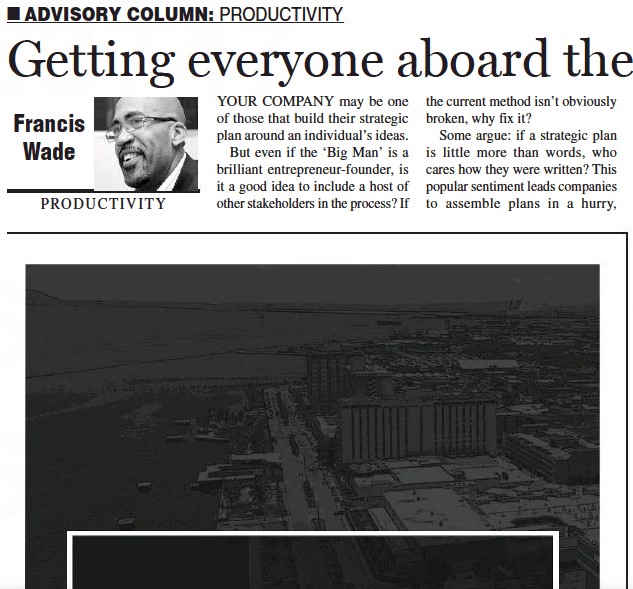Your company is one which builds its strategic plan around an individual’s ideas. But even if the “Big Man” is a brilliant entrepreneur-founder, is it a good idea to include a host of other stakeholders in the process? If the current method isn’t obviously broken, why fix it?
Some argue: if a strategic plan is little more than words, who cares how they were written? This popular sentiment leads companies to assemble plans in a hurry, including as few people as possible. After all, “too many cooks spoil the broth”. And there’s always time to convince board members and staff that the soup tastes great…after the fact.
However, if you are interested in a more inclusive way, here are some methods. They promise a better product and a greater chance of success.
Missing Board Members
In some organizations, the board is excluded from strategic planning activities. Once the final product is completed, they are expected to offer cursory comments, if any.
This approach undermines advisors who have the time and wisdom to think about the big picture: the future of the organization. Untethered from the daily grind, boards are well-suited to consider PESTER forces: Political, Environmental, Social, Technological, Economy and Regulatory/Legal.
If they aren’t capable of this analysis, uninterested, or not permitted…then ask: “Why bother with a board?”
In both private and public sectors, this hard question is rarely asked. Consequently, some board members take a passive approach, failing to show up at meetings and retreats. Their abysmal performance goes unchecked, hidden under a veneer of collegial “blighs”. Friendship trumps stewardship, to the detriment of all concerned.
Instead, have a board which exhibits the highest standard. Or have none at all.
Checked-out Executives
Your senior managers are probably the best result-producers in your company. Why? After all, their track records helped them climb the corporate ladder.
However, these skills have little to do with strategic planning. As such, they feel uncomfortably ill-equipped to think for the long-term. Also, organization-wide cause-and-effect relationships are hard to grasp. Plus, there’s never enough data to make easy decisions and set targets.
They would gladly skip this year’s retreat and leave the whole awkward business to the founder/Big Boss. She can do the heavy lifting. All they need to do is provide a quick blessing once the dust has settled.
In simpler times, with a small organization, this may have worked. Unfortunately, today’s complex COVID-era challenges require more. The full team, with its wide range of skills and experiences, must bring all it can muster to the activity.
Given the fact that your company should be developing a game-changing strategy for 2023, it’s folly to disengage the best minds. Instead, help stakeholders to embrace their incompetence in this area and start learning.
Uninterested Staff
Jamaican executives are often dismayed at their staff’s reaction to the announcement of their grand strategy. First there is silence, followed by a seeming lack of curiosity. No questions are asked, and most employees seem happy to delegate 100% ownership (and blame) to the organization’s leaders.
The conclusion senior managers draw is that staff is disengaged.
That may not be the best interpretation. Consider that the typical non-executive spends most of his/her time on daily tactics. Unfortunately, when faced with questions about the strategic future of the company, they flounder.
The general remedy might be the same for board, executive and staff: engage them all at the start of the process. Conduct open sessions defining the challenges the organization faces. Use PESTER to describe the environment. Ask for stories about competitors, especially if they are indirect, or based outside the Caribbean.
Arrange interviews, focus groups and online surveys to ensure these three levels consider the future and the cost of inaction. At one level, you are asking for their input. But at another, you are sharing responsibility.
Now, your planning retreat becomes more than a mere meeting. It’s a venue to place bets about the future of your enterprise. While it’s not as random as a casino, you need everyone’s best thinking to come together to make the most of your industry’s uncertainty.
This task is so hard that many organizations skip the exercise altogether. They hope that the status quo should suffice. By contrast, leading companies embrace the challenge. They don’t shrink away, but see their courage as a competitive advantage.
Winston Churchill said: “I have nothing to offer but blood, toil, tears and sweat.” You may not have a country to defend against Nazis, but your stakeholders will need to do some heavy lifting. It’s the only way to bring everyone onto the same page.

